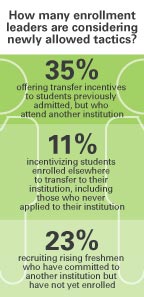Enrollment management officers nationwide may be considering more aggressive tactics to sign on new students as well as defensive ones to retain current students.
Colleges and universities can now offer exclusive incentives for early decision, recruit first-year undergrads who have committed elsewhere, and recruit transfer students, under the National Association for College Admission Counseling’s revised Code of Ethics and Professional Practices. The changes came this past fall under pressure from the U.S. Department of Justice.
Increased competition means higher ed institutions will have to work harder to keep incoming freshmen and currently enrolled students engaged, according to EAB, which recently surveyed enrollment leaders at 150 schools on the guideline changes.

Many administrators are considering the previously prohibited practices, according to EAB’s findings (see graphic, right).
More vulnerable institutions and smaller schools may show a greater inclination to try them, says Madeleine Rhyneer, vice president of consulting services and dean of enrollment management at EAB.
“If this were a world where the market was more right-sized, the change in rules would have less of an impact,” notes Rhyneer, who is a former enrollment officer.
A game of ‘enrollment chicken’
“I have described this new normal to my colleagues and our board as a really big game of ‘enrollment chicken,’” says Sarah Kelly, senior vice president of enrollment, marketing and student affairs at Loyola University New Orleans. “Many seasoned enrollment managers are concerned about being the first out of the gate to fence jump, yet we are also critically concerned about protecting our campuses in this time of demographic shifts and declines. None of us wants to give our competitors the edge.”
A separate EAB survey of 2,000 new college freshmen conducted in 2019 showed that students would consider transferring to another institution to which they had previously applied, citing cost reduction (34%) and full transfer of credits (28%) as among the top incentives.
“Students typically leave institutions for a few reasons: better prestige, more aid/lower costs or more convenience,” says Kelly. “A concern of mine—and of many of my enrollment colleagues—is that some students will make decisions based on net price, at the expense of other factors. Helping students see the big picture is really important.”
Read: Leveraging analytics to boost enrollment
Taking student recruitment actions—carefully
So far, many enrollment leaders are taking a wait-and-see approach.
“While schools do compete for students, we are collegial and professional, and the reputation of how our institution conducts business really matters,” says Brian Ehrlich, vice president of enrollment management at the Florida Institute of Technology. “The higher education community is about educating and caring for our students, and I don’t see overly aggressive business practices resonating with our future students or their families.”
He urges caution to those considering aggressive grabs. “Once a student feels annoyed by texts, emails or other communication, [their] interest is not usually recoverable.”
Before considering any new enrollment practices, communication among campus stakeholders is key. “There are going to be students who leave, and you would do well to develop a model to identify those whom you are willing to fight for and those whom you are willing to let go,” says Kelly. “Every institution needs to have those hard conversations.”
“There are going to be students who leave, and you would do well to develop a model to identify those whom you are willing to fight for and those whom you are willing to let go.” —Sarah Kelly, senior vice president of enrollment, marketing and student affairs at Loyola University New Orleans
EAB’s “Enrollment Strategy After the NACAC Vote” white paper offers more recommendations, including:
- Boost affinity among committed students. Enrollment leaders in contact with UB agree with this point. “It has never been more critical to work across silos and reporting structures to make sure you are giving students a reason to believe—a reason to stay,” says Kelly. “Quick onboarding of new students is crucial—get them scheduled and housed, get them that college ID and make sure they feel welcomed as part of your community.” Adds Kristen Capezza, vice president for enrollment management and university communications at Adelphi University in New York: “The changes in the landscape underscore the importance of creating a personal connection and meaningful engagement with your prospective students—and to ward off potential efforts to lure your students away, following through on that relationship throughout their duration as an enrolled student at your institution.”
Read: How the reach of virtual college advising is expanding
-
Proceed with caution when setting enrollment deposit fees. EAB’s newest survey found that 31% of leaders said they were thinking about upping such fees to discourage committed students from withdrawing. But such a strategy could discourage some students from making a deposit, Rhyneer points out.
- Favor front-loaded financial aid appeals. While an institution may want to secure funding for counteroffers, EAB research suggests that “institutional aid deployed later in the season has less impact than the same amount granted earlier on.”
- Target transfer-student motivations. EAB’s student survey found that less than half (48%) are fully convinced they selected the right institution. Colleges must better understand what students want and need to feel more connected, says Rhyneer.
- Double down on student success efforts. Eliminating potential barriers in course scheduling or credit requirements, for instance, can be beneficial, says Rhyneer. “While you can’t entirely inoculate yourself from an ‘ask’ from another institution, you can do everything you can to remove barriers in business processes to keep students happy.”
Read: How colleges are navigating a new world of enrollment
Will new recruitment strategies work? The vote is out. Rhyneer says, “Simply because it’s an easy lever to pull doesn’t mean it will produce the result you want or is in the best interest of students or the institution.”

